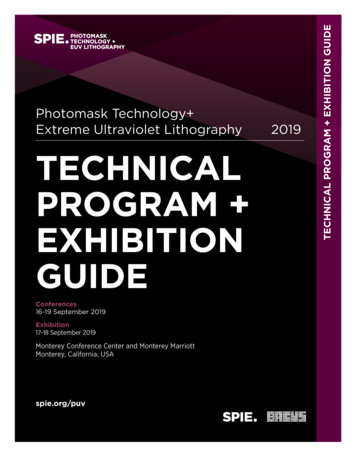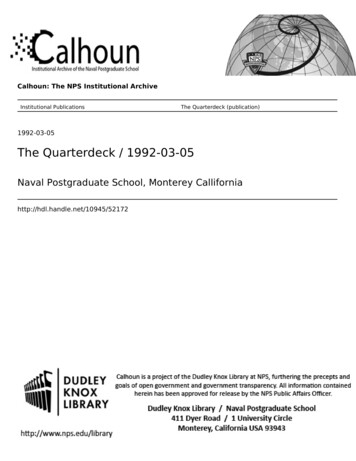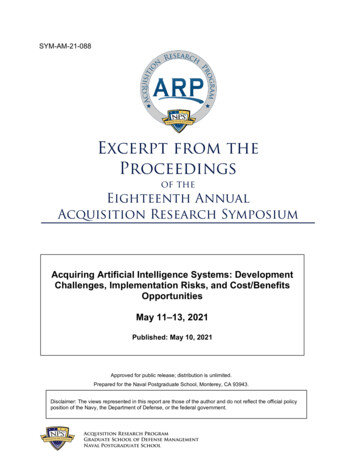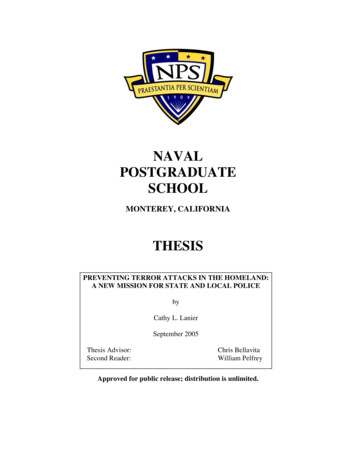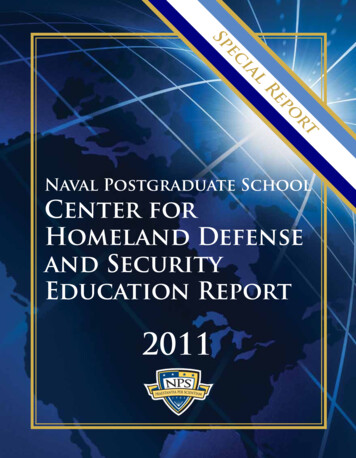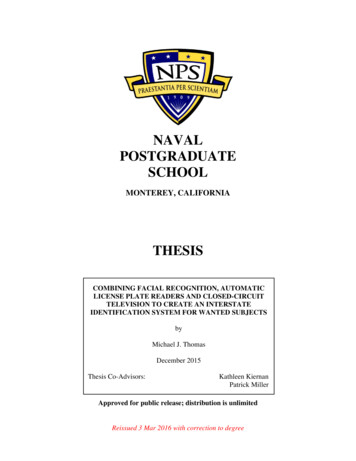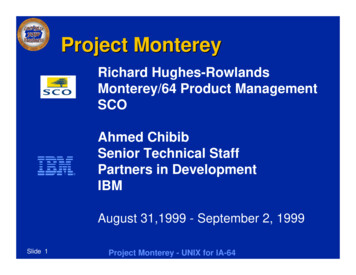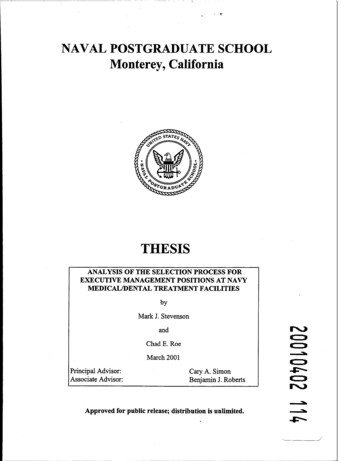
Transcription
NAVAL POSTGRADUATE SCHOOLMonterey, CaliforniaTHESISANALYSIS OF THE SELECTION PROCESS FOREXECUTIVE MANAGEMENT POSITIONS AT NAVYMEDICAL/DENTAL TREATMENT FACILITIESbyMark J. StevensonandChad E. RoeMarch 2001Principal Advisor:Associate Advisor:Cary A. SimonBenjamin J. RobertsApproved for public release; distribution is unlimited.
REPORT DOCUMENTATION PAGEForm ApprovedOMB No. 0704-0188Public reporting burden for this collection of information is estimated to average 1 hour per response, including the time for reviewing instruction,searching existing data sources, gathering and maintaining the data needed, and completing and reviewing the collection of information. Sendcomments regarding this burden estimate or any other aspect of this collection of information, including suggestions for reducing this burden, toWashington headquarters Services, Directorate for Information Operations and Reports, 1215 Jefferson Davis Highway, Suite 1204, Arlington, VA22202-4302, and to the Office of Management and Budget, Paperwork Reduction Project (0704-0188) Washington DC 20503.2. REPORT DATE3. REPORT TYPE AND DATES COVEREDMarch 2001Master's Thesis1. AGENCY USE ONLY (Leave blank)5. FUNDING NUMBERS4. TITLE AND SUBTITLEAnalysis of the Selection Process for Executive Management Positions at Navy Medical/DentalTreatment Facilities6. AUTHOR(S)Stevenson, Mark J. and Roe, Chad E.8. PERFORMINGORGANIZATION REPORTNUMBER7. PERFORMING ORGANIZATION NAME(S) AND ADDRESS(ES)Naval Postgraduate SchoolMonterey, CA 93943-50009.10. SPONSORING /MONITORINGAGENCY REPORT NUMBERSPONSORING / MONITORING AGENCY NAME(S) AND ADDRESS(ES)11. SUPPLEMENTARY NOTESThe views expressed in this thesis are those of the author and do not reflect the official policy or position of the Department ofDefense or the U.S. Government.12b. DISTRIBUTION CODE12a. DISTRIBUTION / AVAILABILITY STATEMENTApproved for public release; distribution is unlimited.13. ABSTRACT (maximum 200 words)This study describes, analyzes and compares Navy Medicine's command screening process. Organizational structure andbehavioral models, and public policy models are used to explain the process and to provide the theoretical framework for the study.Twenty-one semi-structured interviews were conducted with senior stakeholders involved in the process. A written questionnairewas developed to assess the knowledge and perceptions of Navy Medical Department Captains. One hundred forty-six surveyresponses were obtained which showed: the overall process is perceived to be fair and objective and meets the needs of NavyMedicine; self-exemption from selection is an acceptable part of the process; the "best record" is selected; and respondents arefamiliar with the process. Some knowledge deficiencies were uncovered, i.e., who serves on the board, and length of timeindividuals remain in the screened pool. Candidates' primary reasons for seeking command assignments were to improve NavyMedicine, obtain increased responsibility, and personal satisfaction. Recommendations include: continue improvingcommunications between decision makers and prospective candidates; prepare, groom and select officers earlier in the process; andimprove fitness report accuracy in terms of describing actual performance and potential for command.14. SUBJECT TERMS15. NUMBER OFPAGES 204Navy Medical Department Command Screening Process16. PRICE CODE17. SECURITY CLASSIFICATION OFREPORTUnclassifiedNSN 7540-01-280-550018. SECURITY CLASSIFICATION OFTHIS PAGEUnclassified19. SECURITY CLASSIFICATION OFABSTRACTUnclassified20. LIMITATIONOF ABSTRACTULStandard Form 298 (Rev. 2-89)Prescribed by ANSI Std. 239-18
THIS PAGE INTENTIONALLY LEFT BLANK11
Approved for public release; distribution is unlimited.ANALYSIS OF THE SELECTION PROCESS FOR EXECUTIVEMANAGEMENT POSITIONS AT NAVY MEDICAL/DENTALTREATMENT FACILITIESMark J. StevensonLieutenant Commander, United States NavyM.H.A., Chapman University, 1995B.S., Southern Illinois University, 1989Chad E. RoeLieutenant, United States NavyM.B.A., Ball State University, 1994B.S., Indiana University, 1993Submitted in partial fulfillment of therequirements for the degree ofMASTER OF SCIENCE IN MANAGEMENTfrom theNAVAL EOSTGRADUATE SCHOOLMarch 2001Authors:VMark J. StevensonApproved by:Cary A. Simon, Principal Advisorenjamiiil7Robe!AdvisorJ RobensT Associate Adv:Reuben T. Harris, DeanGraduate School of Business and Public Policym
THIS PAGE INTENTIONALLY LEFT BLANKIV
ABSTRACTThis study describes, analyzes and compares Navy Medicine's commandscreening process. Organizational structure and behavioral models, and public policymodels are used to explain the process and to provide the theoretical framework for thestudy. Twenty-one semi-structured interviews were conducted with senior stakeholdersinvolved in the process. A written questionnaire (Likert-scaled and closed-ranking) wasdeveloped to assess the knowledge and perceptions of Navy Medicine Captains (n 146).Statistically significant survey responses were obtained. Results showed the following:the overall process is perceived to be fair and objective and meets the needs of NavyMedicine; self-exemption from selection is an acceptable part of the process and fits theorganization's highly professional nature; the "best record" is selected; and respondentsare familiar with the process. Some knowledge deficiencies were uncovered, i.e., whoserves on the board, and length of time individuals remain in the screened pool.Candidates' primary reasons for seeking command assignments were to improve NavyMedicine, obtain increased responsibility, and personal satisfaction. Recommendationsinclude: continue improving communications between decision makers and prospectivecandidates; prepare, groom and select officers earlier in the process; and improve fitnessreport accuracy in terms of describing actual performance and potential for command.
THIS PAGE INTENTIONALLY LEFT BLANKVI
TABLE OF CONTENTSI.II.INTRODUCTION1A. OVERVIEW1B. RESEARCH SCOPE AND OBJECTIVES2C. RESEARCH QUESTIONS3D. METHODOLOGY4E. ORGANIZATION OF THE THESIS5METHODOLOGY7A. LITERATURE REVIEW7B. QUESTIONNAIRE81. Questionnaire Development82. Questionnaire Distribution9C.INTERVIEWSIII.101. Naval Personnel Command112. Bureau of Medicine and Surgery12ORGANIZATIONAL MODELS REVIEW13A. OVERVIEW13B. EFFICIENCY AND EFFECTIVENESS DEFINED14C. ANALYTICAL TOOLS141. Stakeholder Analysis142. Strengths, Weaknesses, Opportunities, and Threats(SWOT) Analysis17Vll
IV.V.D. MINTZBERG'S ORGANIZATIONAL MODEL19E. SYSTEMS MODEL22F. ELITE THEORY MODEL30G. INCREMENTAL MODEL31H. BUREAUCRATIC-POLITICS MODEL33COMMAND SCREENING PROCESS35A. OVERVIEW35B. MEDICAL DEPARTMENT COMMAND SCREENING PROCESS391. Phase One: CO/XO Screening Board Establishes Eligible Pool402. Phase Two: Potential Candidates Identified/Nominated473. Phase Three: Council of Corps Chiefs Reviews/Approves49C. OTHER NAVY COMMUNITIES COMMAND SCREENINGPROCESSES511. Aviation Community522. Civil Engineering Corps (CEC)533. Fleet Support Community554. Judge Advocate General (JAG) Corps565. Meterology/Oceanography (METOC) Community576. Submarine Warfare Community587. Supply Corps (SC)608. Surface Warfare Community61D. CIVILIAN HOSPITALS EXECUTIVE MANAGEMENTSELECTION PROCESS63COMPARISON OF ORGANIZATIONAL MODELS WITHTHE COMMAND SCREENING PROCESS69vni
A. MINTZBERG'S ORGANIZATIONAL MODEL APPLIED TONAVY MEDICINE1. MTFs/DTFs as Professional BureaucraciesVI.VII.6970a. Operating Core71b. Strategic Apex73c. Middle Line73d. Technostructure73e. Support Staff74B. SYSTEMS MODEL APPLIED TO NAVY MEDICINE74C. ELITE MODEL APPLIED TO NAVY MEDICINE88D. INCREMENTAL MODEL APPLIED TO NAVY MEDICINE89E. BUREAUCRATIC-POLITICS MODEL APPLIED TONAVY MEDICINE90F. STAKEHOLDER ANALYSIS APPLIED TO NAVY MEDICINE91G. STRENGTHS, WEAKNESSES, OPPORTUNITIES, ANDTHREATS (SWOT) ANALYSIS105DATA ANALYSIS111A. INTRODUCTION111B. TARGET GROUP QUESTIONNAIRE111C. STAKEHOLDER INTERVIEWS131CONCLUSIONS AND RECOMMENDATIONS139A. CONCLUSIONS139B. RECOMMENDATIONS145LIST OF REFERENCES149LIST OF INTERVIEWEES153IX
APPENDIX A. TARGET GROUP QUESTIONNAIRE155APPENDIX B. INTERVIEW PROTOCOL-NA VPERSCOM157APPENDIX C. INTERVIEW PROTOCOL-BUMED159APPENDIX D. MEDICAL CORPS CAREER PLANNING CHART161APPENDIX E. DENTAL CORPS CAREER PLANNING CHART163APPENDIX F. MEDICAL SERVICE CORPS CAREER PLANNING CHART165APPENDIX G. NURSE CORPS CAREER PLANNING CHART167APPENDIX H. LIST OF 40 COMPETENCIES169APPENDIX I.171OFFICER EXECUTIVE MEDICINE MATRIXAPPENDIX J. FY01 CO/XO SCREENING SURVEY173INITIAL DISTRIBUTION LIST175
LIST OF FIGURESFigure 1.Stakeholder Identification Worksheet16Figure 2.A Stakeholder Map for a Government16Figure 3.Generating a S.W.O.T Matrix18Figure 4.Mintzberg's Five Basic Subunits20Figure 5.Mintzberg's Professional Bureaucracy22Figure 6.Organizational Systems Model24Figure 7.Elite Model31Figure 8.Incremental ModelFigure 9.Navy Medical Department Command Screening/Selection ProcessPhase One Flow Sheet47Navy Medical Department Command Screening/Selection ProcessPhase Two and Phase Three Flow Sheet50Figure 11.Mintzberg's Professional Bureaucracy72Figure 12.Organizational Systems Model75Figure 13.Stakeholder Identification Worksheet93Figure 14.A Stakeholder Map for Navy Medical CommandScreening Process94Figure 15.Command Screening Process SWOT Summary106Figure 16.Corps Representation and Percentages112Figure 17.Formula for Goodness-of-Fit Test113Figure 18.Question 1 Result114Figure 19.Question 2 Results115Figure 10.:XI33
Figure 20.Question 3 Results116Figure 21.Question 5 Results116Figure 22.Question 6 Results117Figure 23.Question 8 Results1 lgFigure 24.Question 9 Results119Figure 25.Question 10 Results120Figure 26.Question 11 Results120Figure 27.Question 12 Results121Figure 28.Question 16 Results122Figure 29.Question 18 Results123Figure 30.Question 4 Results124Figure 31.Question 7 Results125Figure 32.Question 17 Results130xn
LIST OF TABLESTable 1.Command Screening Process Community Comparison51Table 2.Demographic Questionnaire Results113Table 3.Question 13 Results126Table 4.Question 14 Results127Table 5.Question 15 Results128Xlll
THIS PAGE INTENTIONALLY LEFT BLANKxiv
LIST OF ACRONYMSA.B.M.S.American Board of Medical SpecialistsA.D.A.American Dental AssociationAMAAmerican Medical AssociationA.O.A.American Osteopathy AssociationAQDAdditional Qualification DesignatorASD(HA)Assistant Secretary of Defense for Health AffairsBUMEDBureau of Medicine and SurgeryBUMEDINST 5430.7Organization Manual for Naval Medical and DentalTreatment Facilities (MTFs & DTFs)B.S.N.Bachelor of Science in NursingCAPTCaptainCDRCommanderCECCivil Engineer CorpsCEOChief Executive OfficerCEUContinuing Education UnitsCIOChief Information OfficerCNATRAChief, Naval Air Training CommandCNOChief of Naval OperationsCNPChief of Naval PersonnelCOCommanding OfficerCOMNAVAIRLANTCommander, Naval Air Forces Atlanticxv
COMNAVAIRPACCommander, Naval Air Forces PacificCOOChief Operating OfficerCOMNAVPERSCOMCommander, Naval Personnel CommandDASDirector for Ancillary ServicesDCDental CorpsDCNPDeputy Chief of Naval PersonnelDCSDirector Clinical ServicesD.D.S.Doctor of Dental SurgeryDFADirector for AdministrationDHDepartment HeadD.M.D.Doctor of Dental MedicineDMSDirector for Medical ServicesDNSDirector for Nursing ServicesDoDDepartment of DefenseDONDepartment of the NavyDSGNavy Deputy Surgeon GeneralDSSDirector for Surgical ServicesDTFDental Treatment FacilityEMPRISElectronic Military Personnel Record InformationSystemENSEnsignESCExecutive Steering CouncilFITREPFitness Reportxvi
FYFiscal YearGMEGraduate Medical EducationGMOGeneral Medical OfficerHCAHealth Care AdministrationHCSHealth Care ScientistIGInspector GeneralJAGJudge Advocate General CorpsJCAHOJoint Commission on Accreditation of HealthcareOrganizationsJPMEJoint Professional Military EducationKDHCDKaweah Delta Health Care DistrictLCDRLieutenant CommanderLTLieutenantLTJGLieutenant Junior GradeMANDEVManagement Development CourseMANMEDManual of the Medical DepartmentMBAMasters in Business AdministrationMED-00BUMED Organizational Code for Navy SurgeonGeneral/Chief, BUMEDMED-09BUMED Organizational Code for Navy DeputySurgeon General/Deputy Chief, BUMEDMED-OODCBUMED Organizational Code for Chief, NavyDental CorpsMED-OOMCBUMED Organizational Code for Chief, NavyMedical Corpsxvu
MED-OOMSCBUMED Organizational Code for Director, NavyMedical Service CorpsMED-OONCBUMED Organizational Code for Director, NavyNurse CorpsMETOCMeteorology/OceanographyMCMedical CorpsMHSMilitary Health SystemMILPERSMANMilitary Personnel ManualMSCMedical Service CorpsMTFMedical Treatment FacilityN76Office of the Chief of Naval Operations, SurfaceWarfare DivisionNAVFACNaval Facilities CommandNAVPERSCOMNavy Personnel CommandNHNaval HospitalNMCNaval Medical CenterNMCLNaval Medical ClinicNMOCNaval Meteorology and Oceanographic CommandNNMCNational Naval Medical Center, Bethesda, MDNDCNaval Dental CenterNCNurse CorpsNENurse ExecutiveNLSONaval Legal Service OfficeNOBCsNavy Officer Billet Classification Codesxvin
NRDNaval Recruiting DistrictNSHSNaval School of Health SciencesNWCNaval War CollegeOAISOfficer Assignment Information SystemOICOfficer in ChargeOCONUSOutside the Continental United StatesOJAGOffice of the Judge Advocate General of the NavyOPNAVOffice of the Chief of Naval OperationsOPNAVINST3120.32CStandard Organization and Regulations of the U.S.NavyOP-093Office of the Chief of Naval Operations, DirectorNavy MedicineOSR/PSROfficer Summary Record/Performance SummaryRecordOTMOfficer Transfer ManualPCO/PXOProspective Commanding Officer/ProspectiveExecutive Officer (course)PCSPermanent Change of StationPERS-4415Head, Medical Assignments/Placement Branch,Naval Personnel CommandPERS-4415BHead, Medical Placement, Naval PersonnelCommandPERS-4415GHead, Dental Corps Assignments, Naval PersonnelCommandPERS 44151Head, Medical Service Corps/Health CareAdministration Assignments, Naval PersonnelCommandxix
PERS4415JHead, Medical Service Corps/Health Care SciencesAssignments, Naval Personnel CommandPERS4415KHead, Nurse Corps Assignments, Naval PersonnelCommandPERS4415MHead, Medical Corps Surgical SpecialtyAssignments, Naval Personnel CommandPERS-451FSpecial Assistant for Selection Board Matters,Naval Personnel CommandPRDProjected Rotation DateRLRestricted Line OfficerRLCResponsible Line CommanderRNRegistered NurseSCSupply CorpsSECNAVSecretary of the NavySECNAVINSTSecretary of the Navy InstructionSECNAVINST 1401.3Selection Board MembershipSGNavy Surgeon GeneralSJAStaff Judge AdvocateSORMStandard Organization and Regulations ManualSSNAttack SubmarinesSSBNFleet Ballistic Missile SubmarinesSWOTStrengths, Weaknesses, Opportunities and ThreatsAnalysisTQLTotal Quality LeadershipTQMTotal Quality Managementxx
TSOTrial Services OfficeURLUnrestricted Line OfficerVCNOVice Chief of Naval OperationsVPVice PresidentVTCVideo TeleconferenceXOExecutive Officerxxi
THIS PAGE INTENTIONALLY LEFT BLANKxxii
ACKNOWLEDGEMENTFirst and foremost, we would like to thank Professors Cary Simon and BenjaminRoberts for their assistance in the preparation of this thesis. Their enthusiasm and supportmade this a tremendous learning experience. We would like to thank CAPT MarilynPast, CDR Patrick Kelly and CDR Mark Dobbs at the Naval Personnel Command(NAVPERSCOM) for providing us data and extensive information during the initial datagathering phase of our research. Their assistance led the way for us to better understandthe Medical Department command screening process. We would also like to thank thedetailers and placement officers in the aviation, Civil Engineering Corps, fleet support,Judge Advocate General Corps, meteorology/oceanography, submarine warfare, SupplyCorps and surface warfare communities at NAVPERSCOM for giving up their time andfor allowing us to interview them so openly and candidly. We would also like to thankCAPT Angie Barrow, LCDR Mike Hendee and LT Debra Mortland in the Office of theMedical Service Corps, Bureau of Medicine and Surgery, Washington, DC, for theirsupport in gathering data and arranging interviews prior to our thesis travel toWashington, DC.We also would like to thank the many Directors for Administration at the Navalmedical centers, Naval dental centers, Naval hospitals, Naval medical clinics, researchcenters, and operational units located throughout the world for their assistance indistributing our command screening survey to the Medical Department Captains at theircommand. Their help enabled us to receive an incredible response back from our survey;directing many of our conclusions and recommendations in this thesis.xxm
We would like to give special thanks to CAPT Jerry Anderson and Ms. PatriciaEdwards at the Naval School of Health Sciences (NSHS), Bethesda, Maryland forproviding the financial support to conduct thesis travel to Millington, TN andWashington, DC. Last, but not least, we would like to give special recognition to ourwives, Coral Stevenson and Pam Roe who persevered through the past grueling andarduous 21 months while we attended classes, gathered data and completed our thesis.xxiv
I. INTRODUCTIONA.OVERVIEWThe military healthcare system (MHS) is under pressure to provide increasinglyefficient and effective health and dental care to approximately eight million eligiblebeneficiaries.The advent of TRICARE, Department of Defense (DoD) budgetaryconstraints and the complexity of managing medical treatment facilities (MTFs) anddental treatment facilities (DTFs) around the world, increases the need for talentedleadership.The thesis is about leadership, specifically the process whereby Navalofficers from the four officer communities within Navy Medicine are screened andselected for Commanding Officer (CO) and Executive Officer (XO) positions. Civilianand military healthcare professionals realize the value of having highly qualified leadersin executive and command positions. Selecting the best leaders is critical for successfulperformance of MTFs and DTFs facing tough choices in a complex healthcareenvironmentPrior to 1989, the Navy Surgeon General (SG) selected the COs and XOs ofMTFs and DTFs. However, the Secretary of the Navy (SECNAV) and the Chief ofNaval Operations (CNO) established a Department of the Navy (DON) Medical BlueRibbon Panel in 1988 to evaluate different aspects of the Navy Medical Department. ThePanel's final report uncovered the following issue: "There are no identifiableprerequisites, career path or formal criteria to select and assign properly trained andproven personnel to leadership positions leading to command similar to ones VCNOestablished for COs in 1982 and XOs in 1987 for the Unrestricted Line (URL)1
community.Selection criteria is based on seniority and general experiences, but nospecific training courses or prior assignments are required for selection." The Panelrecommended: "Unrestricted line officer career paths provide a proven stepping stoneapproach that develops and hones leadership skills through ever-increasing levels ofresponsibility leading to command. A similar system is needed for Medical Departmentofficers." In response to this report, a formal Medical Department command screeningboard was established in 1989 at the Naval Personnel Command (NAVPERSCOM),which incorporated distinguishable career paths and screening elements to identify thepool of "best qualified" officers for all Medical Department MTF/DTF CO/XO billets(Medical Department Officer Career Guide, 1991).B.RESEARCH SCOPE AND OBJECTIVESThis analysis includes all relevant policies and processes involved in the MedicalDepartment command screening board to identify future COs and XOs of the twenty-twonaval hospitals, five ambulatory care clinics, and fifteen dental centers locatedworldwide. The overall selection process is described from the perspective of fourstakeholder groups: target group; decision makers; implementers; and influencers(Quade, 1989). Potential CO/XO candidates from the four officer communities withinNavy Medicine (Medical Corps, Dental Corps, Medical Service Corps, and Nurse Corps)are addressed in this study as the "target group" of stakeholders (Quade, 1989).Organizational structure and behavioral models, and public policy models are used toexplain the process and MTF/DTF design characteristics, and to provide the theoreticalframework for this study. These models include: Mintzberg's Organizational DesignModel; Elitist; Incremental; Bureaucratic-Politics; and Organizational Systems models2
(Mintzberg, 1993; Dye, 1995; Nadler & Tushman, 1991; Roberts, 2000; and Lindblom,1995). The Medical Department command screening process is also compared to otherNavy line and staff corps' selection processes, as well as civilian health care executivescreening and selection.The study describes and analyzes how the Bureau of Medicine and Surgery(BUMED) selects its current and future leadership. It answers questions concerning theefficiency of actually a series of processes used to identify and select future leaders. Itdraws conclusions on how effective the overall selection system is in terms of adapting toa rapidly changing post-Cold War and post-Desert Storm environment. Medical anddental officers can use the study to increase their understanding of the command selectionprocess. The study describes the sequential steps, identifies perceived strengths andweaknesses, and provides suggestions for streamlining and improving the efficiency andeffectiveness of the overall process. The research identifies the various stakeholdersincluding their perceived level of knowledge and understanding, and makesrecommendations for improvements.C.RESEARCH QUESTIONSThe following research questions are addressed:1. How efficient and effective are the current Navy Medical Departmentcommand screening processes (i.e., how labor intensive and how adaptive)?2. What models describe and explain the command screening system andprocesses?3. What are the overall sequence of factors contributing to screening andselection of CO/XO positions, and how do various sub-processes relate?4. Who are the major stakeholders in the screening and selection process andwhat are their roles, responsibilities, and levels of understanding?5. What are the similarities and differences between the four officer Corpswithin Navy Medicine concerning screening and selection?
6. What other factors may impact the command screening process, e.g., selfexemption of eligible candidates, level of understanding and consensusregarding equity and validity of the process?7. How does the screening and selection process compare and contrast to the lineand other Navy staff Corps?8. How can the Navy Medical Department command screening process beimproved?D.METHODOLOGYThree primary methods of data collection are used to answer the researchquestions: 1) literature model review/document analysis; 2) a written, Likert-scaledsurvey, and 3) semi-structured interviews with 21 senior stakeholders. Current DoD andNavy regulations, Navy Medicine doctrine, and governmental reports coveringqualifications of personnel eligible for command screening are reviewed for backgrounddata. Additionally, organizational and policy models applicable to the topic are describedand infused into the analysis to provide a theoretical framework. Stakeholder analysisand Strengths, Weaknesses, Opportunities, and Threats (SWOT) analyses are used astools to describe the screening and selection process.A written questionnaire (Likert-scaled and closed ranking) was used to ascertainstakeholders' knowledge and perceptions concerning the command screening process.The questionnaire was designed for Navy Medical Department Captains (CAPTs) andCaptain selects (CAPT(select)) representing the Medical Corps (MC), Dental Corps(DC), Medical Service Corps (MSC), and Nurse Corps (NC). Interviews were conductedwith the Navy Surgeon General and the Directors of the MC, DC, MSC and NC.Interviews were also conducted with various personnel involved in the commandscreening process as well as line officer counterparts and other staff corps careermanagers.
E.ORGANIZATION OF THE THESISChapter II outlines the research methodology used during the literature search,semi-structured interviews and survey development and implementation. Chapter II alsodetails the structure and purpose of the written questionnaire.Chapter III discusses the models and theories applicable to the Navy MedicalDepartment command screening process, and Chapter IV provides a detailed descriptionof the processes, including preparation for the formal selection board through theselection of individuals for command assignments. Chapter IV also describes eight otherNavy line and staff Corps' communities command selection processes, as well as civilianhealthcare Chief Executive Officer (CEO) and Chief Operating Officer (COO) selectionprocesses.Chapter V analyzes the models and theories as they pertain to MTF's/DTF'sorganizational structures and the Navy Medical Department command screening process.Chapter V provides a detailed stakeholder analysis and a SWOT analysis based oninterviews with senior Navy Medicine leaders. Chapter VI analyzes the target groupsurvey results and the interviews conducted with 21 major stakeholders involved in theprocess.Chapter VII contains conclusions and recommendations generated from the studyand answers the research questions. Areas for improvement are addressed as well aspossible areas for follow-on research.
THIS PAGE INTENTIONALLY LEFT BLANK
II. METHODOLOGYThe research methods used in this thesis concentrated on three main areas: aliterature search and models review, a written, Likert-scaled survey, and personalinterviews. In describing the command screening process, emphasis was placed on thepersonal interviews with 21 major stakeholders involved in the process since literature onthe topic is limited.The three research methodologies were selected for theirapplicability in answering the research questions, i.e., a complex process is describedfrom several theoretical perspectives, and tools are used to capture diverse stakeholderperceptions concerning the process.A.LITERATURE REVIEWLiterature dealing with the Navy Medical Department's command screeningprocess is limited, therefore the literature review concentrated on explanatoryorganizational behavior/structure and public policy models. Textbooks and articlesdescribing the organizational structures, systems and configurations were examined andcompared with aspects of the topic. For example, Mintzberg's (1993) professional andmachine bureaucracy configurations, and Roberts (2000) Organizational SystemsFramework are particularly relevant.In researching the Medical Department command screening process, it wasfundamental that the organizational mandates (laws, regulations and instructions) thatimpact the process be examined. Bryson (1995) notes that mandates depict what anorganization must and should be accomplishing.Some of the specific documents(mandates) that have a major influence on the command screening process include: Title
10 - United States Code, Secretary of the Navy instructions (SECNAVINST) coveringselection board membership, U.S. Navy Medical Department Officer Career Guide, FinalReport of the Medical Blue Ribbon Panel which directed the establishment of a formalcommand selection board, Military Personnel Manual (MILPERSMAN), OfficerTransfer Manual (OTM), BUMED Organizational Manual for Navy Medical and DentalTreatment Facilities, FY01 Command Selection Board Precept, U.S. Navy Regulationsand Naval Personnel Command inter-departmental correspondence.B.QUESTIONNAIREA written, Likert-scaled questionnaire (Appendix A) was used to ascertainstakeholders' knowledge and perceptions concerning the command screening process.The questionnaire was designed for Navy Medical Department Captains (CAPTs) andCaptain selects (CAPT(select)) representing the Medical Corps, Dental Corps, MedicalService Corps, and Nurse Corps.1.Questionnaire DevelopmentTwo literature sources were used in developing the questionnaire: How toConduct Surveys, (Fink & Kosecoff, 1998), and Asking Questions: A Practical Guide toQuestionnaire Design, (Sudman & Bradburn, 1982). Using these two sources as guides,the objective was to develop a concise questionnaire that was user-friendly to respondentsand would provide quantifiable data concerning their perceptions. The questionnaire wasdistributed by electronic mail to 1,200 potential candidates. One hundred forty-six usablesurveys were completed and analyzed.In developing the questionnaire, several key factors were considered. First, therespondents were informed about the motive of the study, i.e., a Naval Postgraduate8
School thesis to describe and improve the command screening board process. Second,the respondents were informed how to interpret the questions, and where and when toreturn the questionnaire. Informing the respondents on how to interpret was importantbecause several questions required the respondents to select/rank their best three answers,and other questions required Likert-scaled responses. Participants were promisedanonymity, i.e., no names are used in the thesis. All of the above factors were explainedin the respondent instruction section located on the first page of the questionnaire.Another factor in developing the questionnaire involved the sequence of questions.Questions were listed in a logical order so that respondents could more easily relate to thescreening and selection process.Another factor built into the questionnaire included some questions designed tocheck respondents' consistency, or knowledge level in several areas. Questions askingfor specific answers were purposely repeated to validate previous answers. The purposewas to assess perceptions and knowledge. Lastly, it was important to let the respondentsknow their efforts were greatly appreciated by ending the survey with a since
M.H.A., Chapman University, 1995 B.S., Southern Illinois University, 1989 Chad E. Roe Lieutenant, United States Navy M.B.A., Ball State University, 1994 . MBA MED-00 MED-09 MED-OODC MED-OOMC Fiscal Year Graduate Medical Education General Medical Officer Health Care Administration
